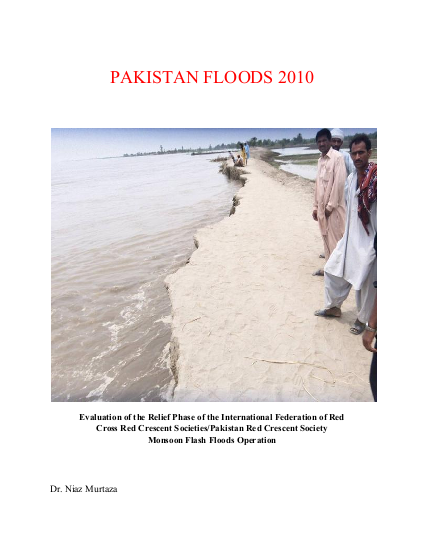
The Pakistan Flood was one of the largest humanitarian emergencies ever in terms of the number of people affected. UNOCHA estimates indicate that almost 2000 people were killed, over 1.7 million homes were destroyed and almost 18 million people were seriously affected by it. At the worst point, approximately 20% of Pakistan's total area was underwater, an area bigger than England. The country suffered extensive damage to health, educational, transportation and communication infrastructure and crops. The total economic impact is estimated to be as much as 10 billion USD. While camps have largely been dismantled and the overwhelming percentage of people has returned to their villages, huge recovery needs persist in the areas of shelter, water, sanitation, infrastructure and livelihoods in villages. The IFRC/PRCS joint response, with a total appeal target of over CHF 130,000,000 for a 24 month period, focused on provision of food, NFI, health, water, sanitation, shelter and livelihoods services to nearly 191, 000 families during the relief phase from August 2010 to February 2011 in PK, Punjab and Sindh provinces. The evaluation was commissioned by the IFRC’s Asia Pacific Zonal Office in Kuala Lumpur for the purpose of accountability and learning. Specifically, it aims to assess the relief phase of the joint Pakistan Red Crescent Society/International Federation of Red Cross Red Crescent Societies/ Monsoon Flash Floods Operation using the following criteria: compliance with standards/expectations; relevance and appropriateness; effectiveness; efficiency (including cost effectiveness); coverage; impact; coherence; connectedness; and accountability to beneficiaries. The information for the evaluation was collected through secondary documents, interviews with IFRC and PRCS staff and focus group discussions with 18 communities in the three provinces. The main evaluation constraints included the high turnover among agency staff and beneficiaries, the significant length between the end of the relief phase and the evaluation, the weak documentation and the lack of coordination among IFRC and PRCS about this evaluation.
